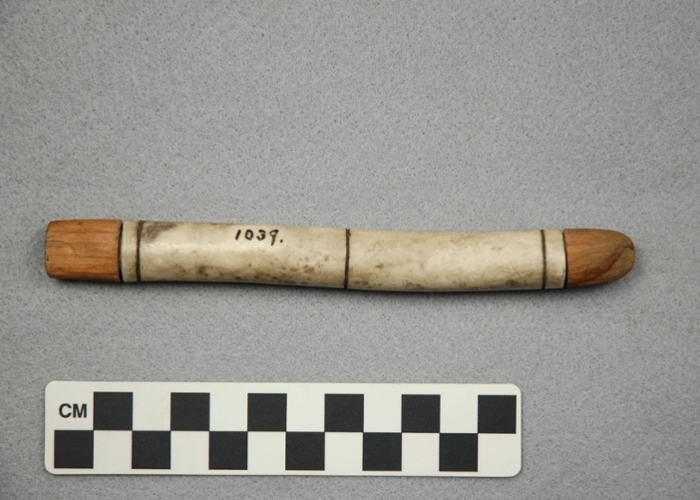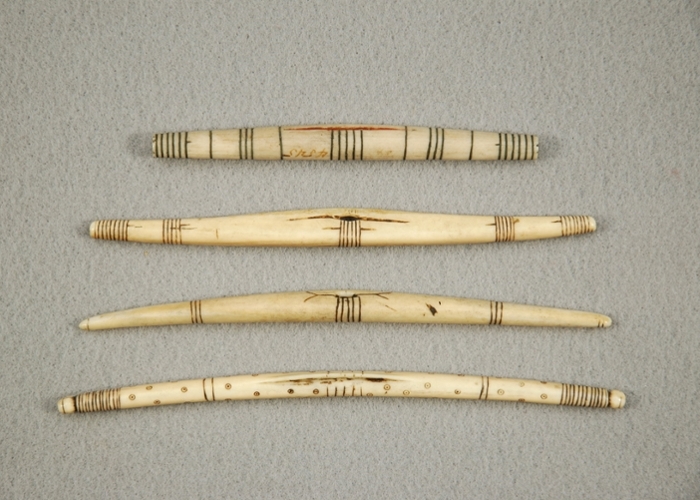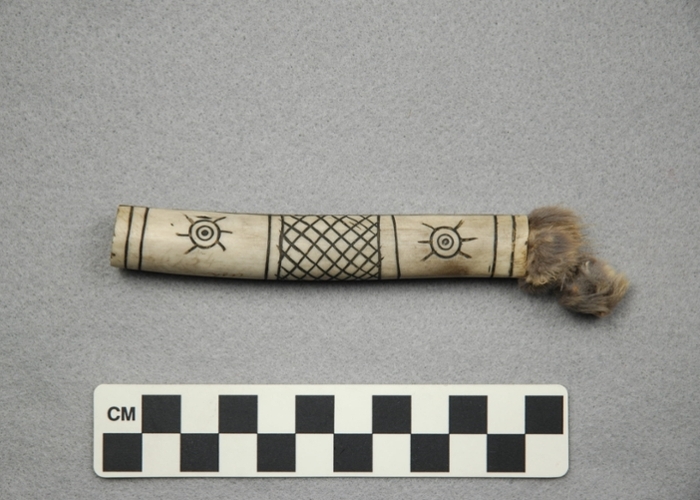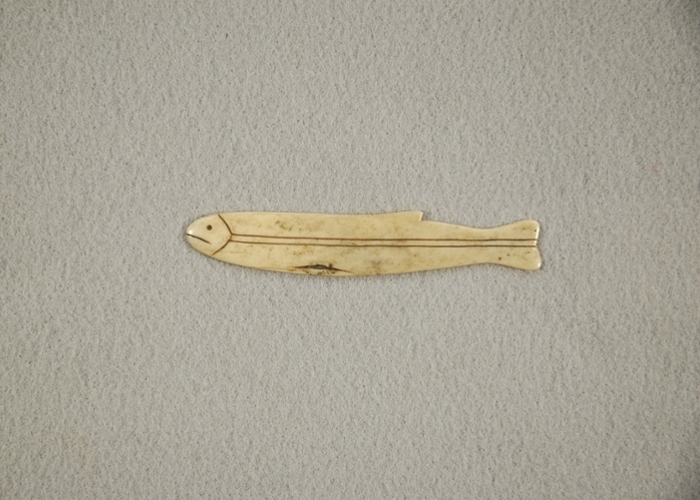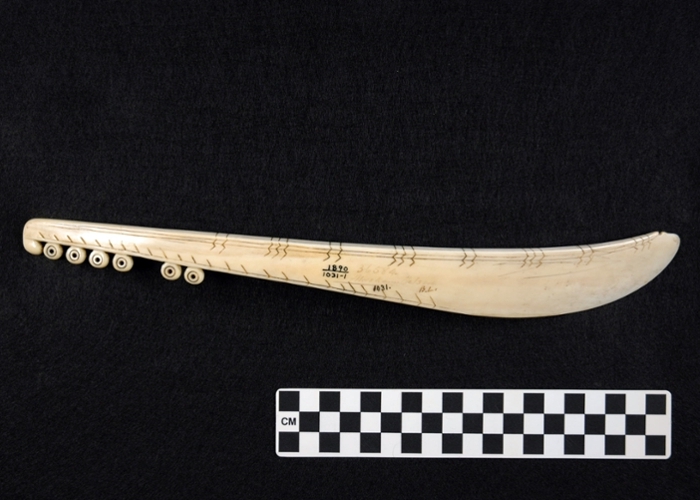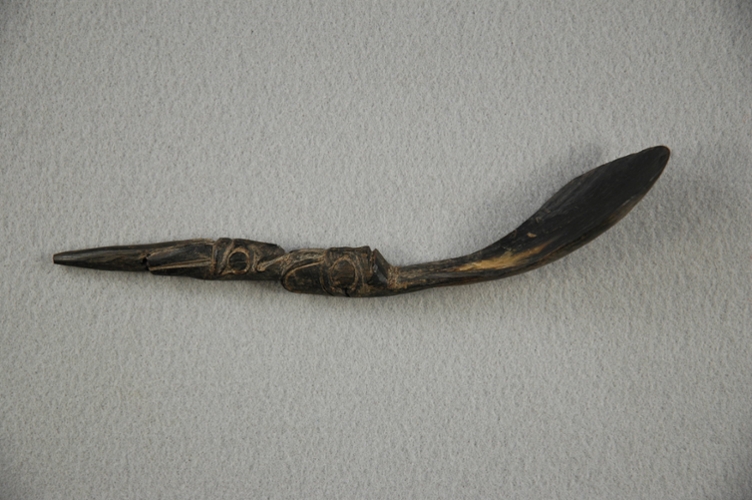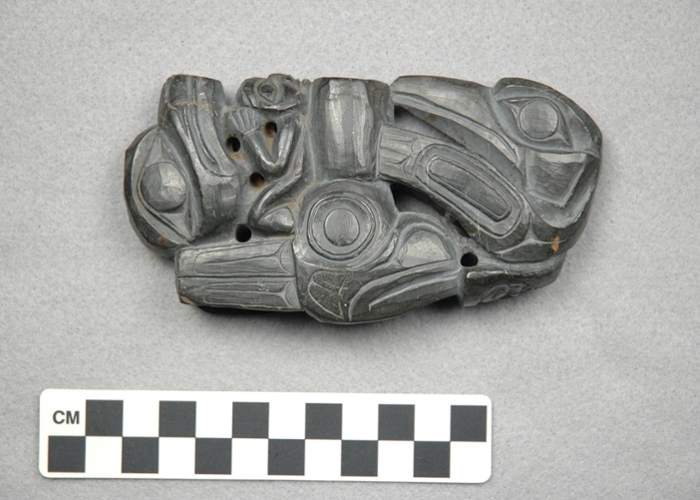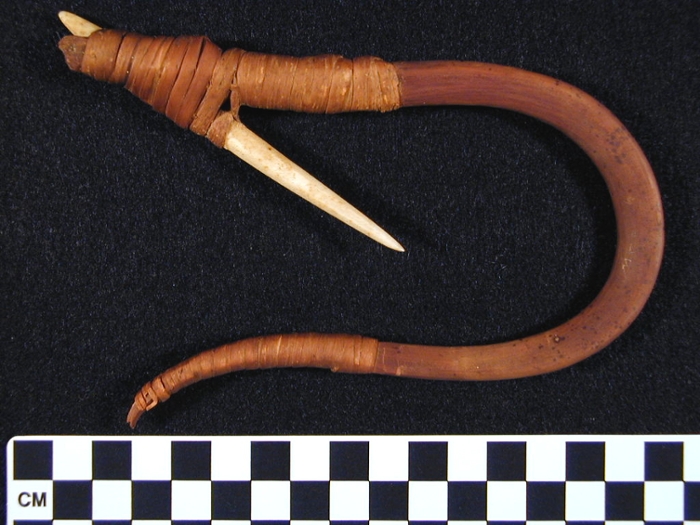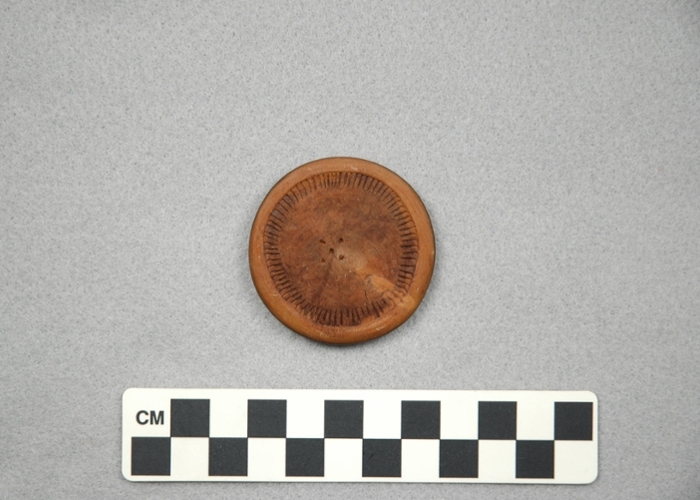Alaska and the Pacific Northwest
-
Needle Case
WUM Ethnology 1039
Lower Kuskokwim River region, Alaska, prior to 1878
Ex-collection Smithsonian InstitutionSewing was a vital skill to Yup'ik and Cup'ik peoples, necessary for creating and maintaining the clothing and equipment that allowed them to hunt marine mammals and flourish in a sub-arctic environment. Women did the bulk of the sewing, but men also carried sewing kits on hunting expeditions to make on-the-spot repairs.
Nelson collected numerous tools related to sewing, including needle cases like this one. It is made of a section of hollow bird bone with wooden plugs at each end. The differing plug shapes are intentional, likely meant to give the closed case the profile of a fish. On many of the cases Nelson collected, the plugs are explicitly carved into fish heads and tails.
-
Bag Fasteners
WUM Ethnology 1033, 1035-1037
Yukon-Kuskokwim Delta, Alaska, prior to 1878
Ex-collection Smithosnian Institution
Range 10 cm to 14.6 cm longA woman's sewing bag, or kakivik in Central Alaskan Yup'ik, was rolled up when not in use and secured by means of a rawhide cord and bone or ivory fastener. The cord would be wound round the rolled-up bag, with the attached fastener tucked under the cord to keep it in place. Nelson referred to these bags as "housewives" after the similar kits used by European and American women and well-known to soldiers and sailors responsible for mending their own uniforms.
These fasteners are from (top to bottom), Cape Vancouver, Sfugunugumut, Askinuk, and the Lower Kuskokwim River region (village unspecified).
-
Needle Case
WUM Ethnology 1040
Askinuk, Alaska, prior to 1878
Ex-collection Smithsonian InstitutionThis needle case, or mingquciivik in Central Alaskan Yup'ik, is made from a section of bird bone, most likely a large waterfowl. Bird bones are handy for this purpose because they are naturally hollow. Originally, it would have been plugged at both ends. The remaining plug is trimmed with fur, and the carved designs are enhanced with black pigment.
-
Bag Fastener
WUM Ethnology 1032
Nunivak Island, Alaska, prior to 1878
Ex-collection Smithsonian Institution
9.2 cm longNunivak is a large volcanic island in the Bering Sea, opposite the Yukon-Kuskokwim Delta. The Nuniwarmiut (residents of Nunivak Island) or Cup'it people speak a variant of Central Alaskan Yup'ik called Cup'ig.
This bag fastener from Nunivak is carved in the shape of a fish, possibly a salmon, or cayag in Cup'ig. Nelson collected several fasteners shaped like fish, as well as seals and whales. Fasteners were used to secure the soft, compartmentalized bags used as sewing kits, which were rolled up when not in use. A cord would be wound round the rolled-up bag, with the attached fastener tucked under the cord to keep it in place.
-
Story Knife
1890.1031.1
Big Lake, Alaska, prior to 1878
Ex-collection Smithsonian InstitutionIvory tools such as these were used, mainly by girls, to sketch pictures on the ground to accompany a story or song. This could also be incorporated into a game where others tried to guess the story the artist was illustrating.
Called a "snow knife" by Nelson - he made his collecting expedition during winter, and thus observed children carving pictures in snowbanks - the name for this tool in Central Alaskan Yup'ik is yaaruin, or "story knife."
-
Horn Spoon
2004.13.18
Chilkat, Alaska, prior to 1888
Ex-collection Abby Johnson Woodman
Ex-collection M. Gilbert and Beatrice M. Burford
Gift of James van B. Dresser '63Mrs. Woodman, cousin of poet and abolitionist John Greenleaf Whittier, spent the spring of 1888 traveling along the Northwest Coast by rail and boat. She describes her journey in Picturesque Alaska: A Journal of a Tour Among the Mountains, Seas and Islands of the Northwest, from San Francisco to Sitka (Boston: Houghton Mifflin, 1889).
According to her journal, she obtained this Haida or Tlingit spoon near present-day Haines, AK. It is made from the horn of a mountain goat, and would have traditionally been used to ladle seal and fish oil.
-
Panel Pipe
1871.217.1
Alaska, prior to 1871
Gift of the Missionary Lyceum
13 cm x 6.5 cm x 2.5 cm greatest dimensionsThe Haida are world-renowned for their carvings made from the unique black argillite mined on Haida Gwaii in British Columbia. This industry took off in the 19th century when, as the trade in sea otter pelts declined, Haida carvers began making pipes, dishes and other objects to sell to European and American travelers.
Panel pipes, with their complex designs of intertwined figures, became a prized form of collectible sculpture. Though this pipe is technically functional, it does not appear to have been used for smoking. It features Raven, Eagle and other Haida motifs.
-
Halibut Hook
WUM Ethnology 1697
Puget Sound, Washington, prior to 1901
Gift of Albert R. Crittenden
This halibut hook resembles those recovered from the Makah village excavated at the Ozette site on the Olympic Peninsula. The Makah made these hooks by steaming wooden sticks inside kelp bulbs until they could be bent into the desired shape. The bone barb is lashed on with what is probably cedar bark. -
Gaming Disk
WUM Ethnology 140
Oregon, prior to 1868
Ex-collection Dr. Simeon Shurtleff
4.8 cm diameter
Guessing games are ubiquitous amongst the indigenous peoples of the Pacific Northwest. They are played in a community setting, often accompanied by singing and drumming. The object is for the players to identify which of two or more piles or bundles contains a specially marked disk or reed. Usually several rounds are played, with players or teams accumulating points for correct guesses.
This wooden disk is painted black along its edge in addition to having carved markings. It would have been hidden amongst unpainted disks beneath piles of shredded cedar bark.
